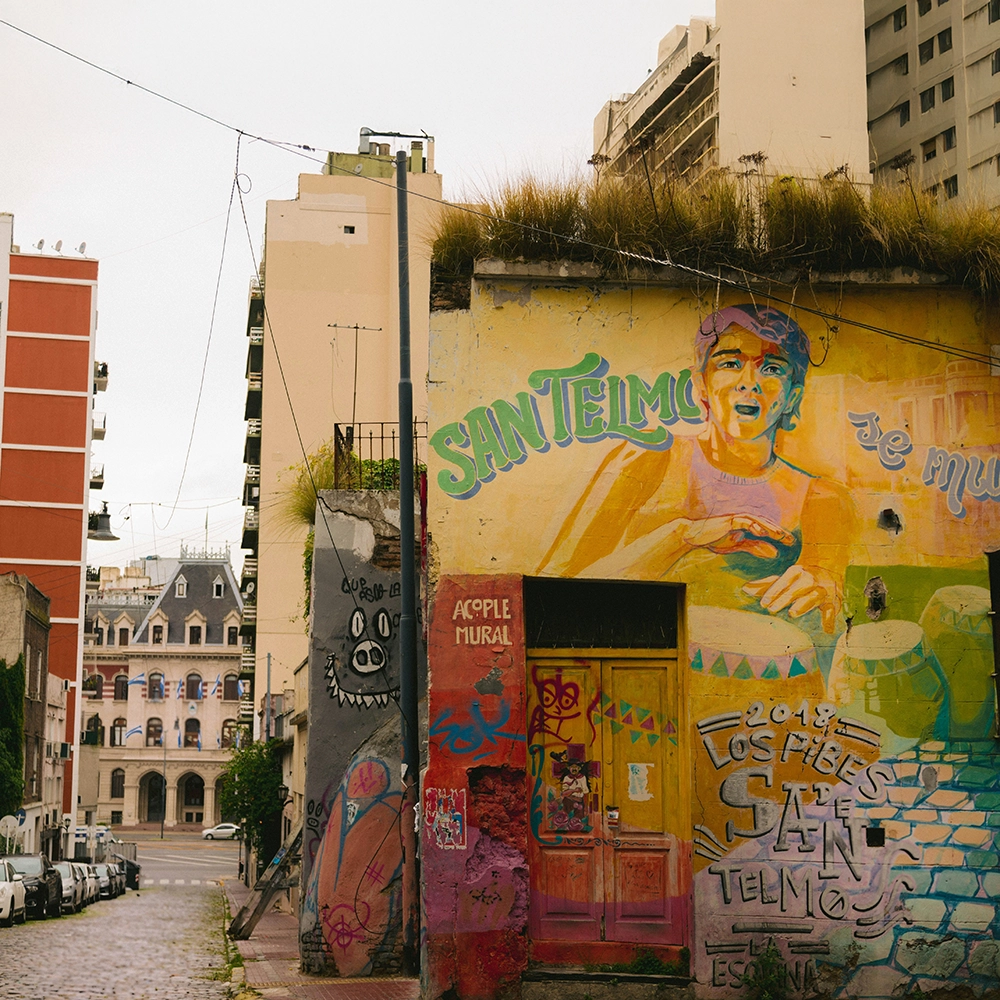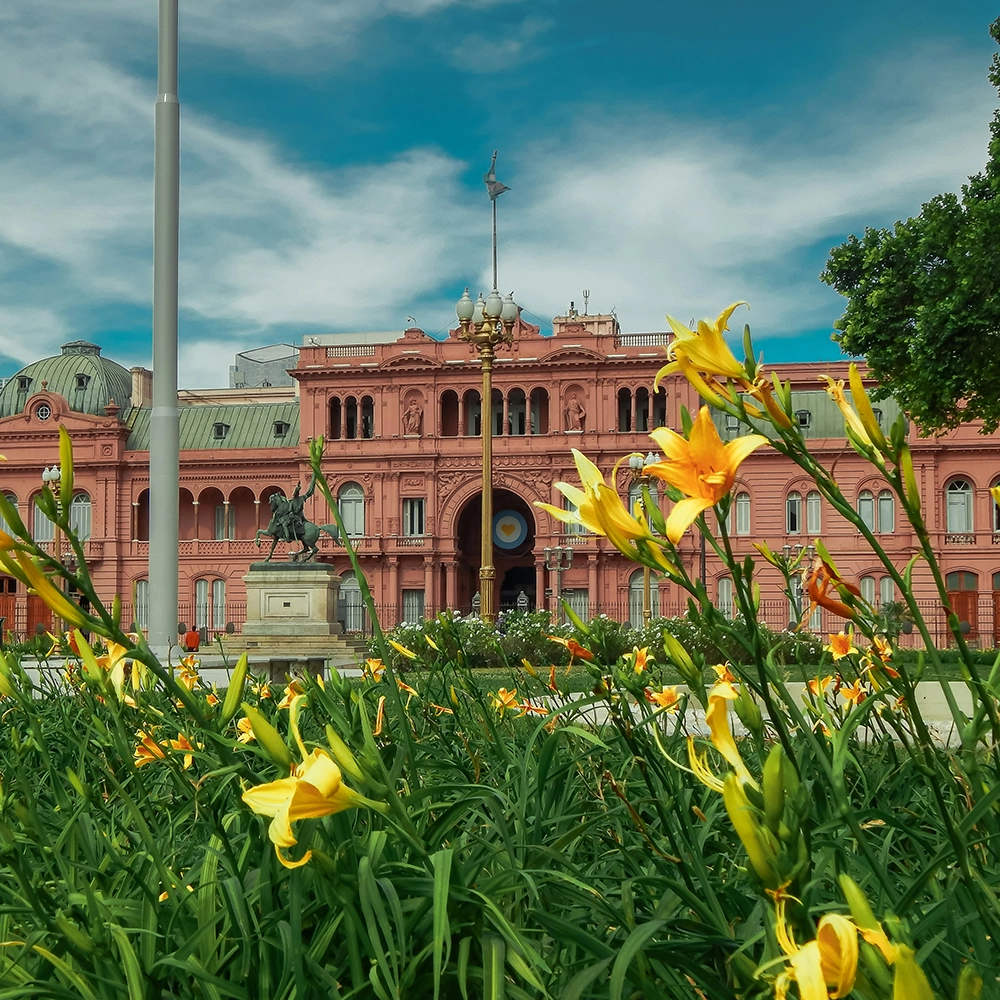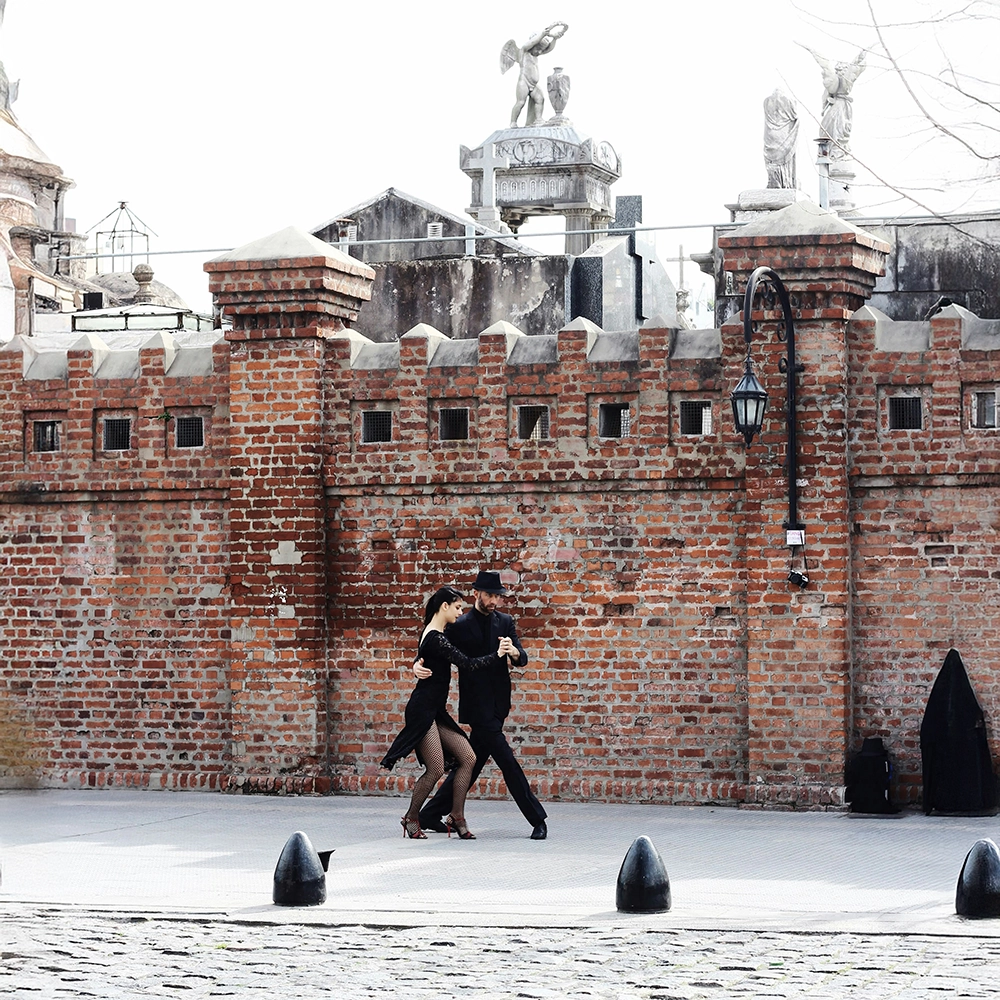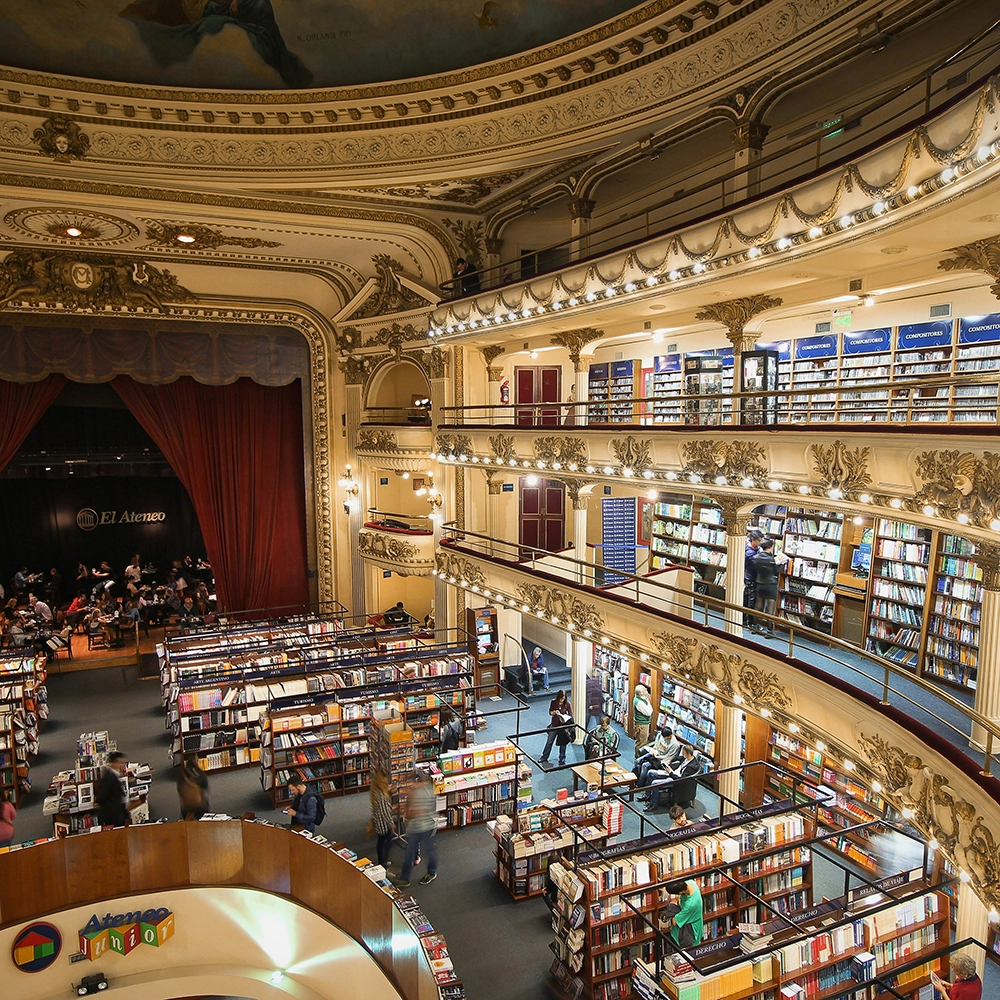If you’ve ever dreamed of steamy back rooms where sophisticated men and women twirl, dip, and slide across the dance floor with more passion, sensuality, and poise than you’ve ever mustered at any one time, then Buenos Aires is a must.
Not to mention the men and women are clad in their finest evening attire — full tuxedos, sleek gowns, stilettos, attitude. And never mind that they could be anywhere from 18 to 70 years old while showing little to no discernible difference in vigor and beauty — despite the fact that it’s past 5 a.m.
Buenos Aires is an enchanting city, full of wrought-iron balconies lined with flower boxes, long avenues of old European-style architecture, and bustling neighborhoods rich with street art. Its affinity for intimate sidewalk cafes, elegant fashion, and artistic flair lead some people to call Buenos Aires the Paris of Latin America — but as any porteño would tell you, it’s so much more.
Where is Buenos Aires?
Buenos Aires is on the Atlantic coast of Argentina. So many of the original European settlers came by boat to the port city, giving them the nickname porteños, which they still use today.
Getting To and Around Buenos Aires
There are three Buenos Aires airports, the biggest being Ministro Pistarini International Airport in Ezeiza (EZE). This is likely where you’ll land if you're flying internationally.
Alternatives are the Jorge Newberry Airport (AEP) and El Palomar (EPA), but they are mostly limited to domestic flights. A few airlines may fly there from neighboring countries as well.
If you’re arriving from nearby Uruguay, consider taking a ferry instead of flights to Buenos Aires. There are a few companies that run boats between Montevideo and Colonia de Sacramento in Uruguay and Puerto Madero and La Boca in Argentina.
Once you get to Buenos Aires, the best ways to get around are on foot or by taking public transportation. You can do rideshares, but between the Subte (subway), buses, and trains, you can get just about anywhere in the city.
I always advocate for walking as the best way to get to know a city. Life happens on the street. The first time I went to Buenos Aires, I was there with a friend for a mere 40 hours. In that time, we walked 35 miles.
The metro system gets you anywhere you need to go for very little money. In rush hour, it’s a speedy option, too. Get a SUBE Card, which is a prepaid card you can use on buses, trains, and subways. Drivers do not take cash, so this contactless option is really the only way to go.
Get your SUBE Card at the airport and top it off at kiosks as needed.
Do I Need a Visa for Argentina?
U.S. citizens must have a valid passport with at least one blank page and six months remaining before expiration. They do not need a visa if they are traveling for tourism and are staying for 90 days or less.
Where to Stay in Buenos Aires
Buenos Aires has lots of unique neighborhoods. For centrality, I like staying in Recoleta. This is a more modern and ritzy area. It’s nice to stroll through and has plenty of restaurants and other spots to check out. If you’re looking for nightlife, though, there are better options.
San Telmo is the oldest part of the city, dating back to about the 17th century. Not surprisingly, the neighborhood has changed quite a bit over the last few hundred years. Today, it’s famous for its bohemian vibe with art galleries, street murals, and eclectic mix of bars and restaurants.
Palermo is a single neighborhood that can be divided into even more enclaves. For parks and gardens, check out Bosques de Palermo (Palermo Woods). For trendy stores and restaurants and unique boutique hotels, look in Palermo Soho. This is also where you’ll find some prime tango.
What to Do in Buenos Aires in 3 Days
Day 1: City Highlights
Start in the center of downtown. Here you’ll see the Casa Rosada, the Plaza de Mayo, and a slew of fancy government buildings. The Casa Rosada is the Argentine version of America’s White House, although this pink palace might be more recognizable as the balcony where Eva Perón delivered her most famous speeches in the 1940s and 50s.
Be sure to read up on Las Madres de la Plaza de Mayo. It’s a human rights group that got its start during the Dirty War, one of the darkest parts of Argentine history. More than 20,000 people disappeared during the country’s military dictatorship in the 1970s and 80s, kidnapped and often killed by the government. Their mothers — las madres — began protesting in the plaza, demanding the return of their children and answers to their whereabouts.
Although some people have now been “missing” for nearly 50 years, Las Madres de la Plaza de Mayo continue to march in the plaza every Thursday.
Walk northwest toward the Obelisco at the intersection of the grand Avenida 9 de Julio and Avenida Corrientes. The national monument commemorates Argentina’s 400-year anniversary. If the city happens to be celebrating something during your visit — a big fútbol win perhaps — this is where people will gather to sing, jump around, and drink beer.
A few blocks from there is the famous Teatro Colón, home of ballets, operas, and other concerts. Even if you can’t stay for a show, you’ll want to explore inside. Guided tours are offered in Spanish every 15 minutes or four times a day in English.
Walk north up the pedestrian Calle Florida (Florida Street) for music, architecture, and shopping. Grab a coffee or an ice cream while you watch some talented amateur tango by street performers.
If you’re up for it, head back to city center for a night out. Otherwise enjoy some well-earned rest for tomorrow.
Day 2: La Boca and the Tango
Again start in the city center, but this time walk south through San Telmo, one of the oldest areas of Buenos Aires. Be sure to stop through Paseo de la Historieta and San Telmo Market.
Continue down to La Boca, "the most Instagrammable neighborhood in Buenos Aires.” It’s a working-class neighborhood with loads of flavor. Stepping into La Boca is stepping into vibrant world of color, music, and character. Spend some time wandering around here, grab a bite to eat, stay awhile and appreciate the vivacity.
Metro or Uber back to where you’re staying and get ready for a night of drinks and tango in Palermo Soho. A night of dancing is one activity in Buenos Aires you don’t want to miss.
There are two general species of milongas, or tango bars: extravagant tourist shows and nondescript local digs. Both are magnificent in their own right.
The extravagant tourist shows often come with dinner and drinks, paid professional dancers in full costume, and ticket prices upwards of $80 per person.
The nondescript local digs, on the other hand, are essentially just nightclubs specific to tango where local people go to drink and dance. They are significantly less orchestrated, but the dance is performed with no less flair.
Instead of watching from an assigned theater booth, you cluster around a side table alongside dancers taking breaks to drink and chat. Instead of paying $80+, you pay around $5 for the entrance fee and $10 for a bottle of wine to share. Instead of arriving for a firm 9 p.m. start time, you arrive any time after midnight, bearing in mind that the dancing often heats up around 3 a.m.
If you choose the local milonga, I recommend the fabulous Milonga Parakultural. The place was so nondescript that we unknowingly walked right by it four times before realizing where the entrance was.
Tucked away in the bohemian neighborhood of Palermo Soho, this place boasted a live orchestra, lavish attire, and dancing that had us enchanted for hours.
Day 3: Art and nature
Once you've recovered from a late night (or early morning) of tango, stroll up to Avenida Santa Fe and walk west. Don’t miss the old theater-turned-modern bookstore, El Ateneo Grand Splendid. Considered the most beautiful bookstore in the world, luxury boxes are now reading nooks and the stage is now a cafe serving cappuccinos and pastries.
From there, head north to el Cementerio de la Recoleta. The most visited cemetery in Buenos Aires, it houses above-ground mausoleums of marble and stone that hold many Argentine aristocrats from past centuries.
Even if you’re not usually into exploring gravesites, you might appreciate this site for its architecture. Many of the mausoleums have been declared national historic monuments for their design and sculptures.
Continuing north, you’ll find a smattering of worthwhile museums mostly along the same road: the Museo Nacional de Bellas Artes and the Museo Nacional de Arte Decorativo are both free to visit, while the MALBA (Museum of Latin American Art) costs less than $6 USD (as of April 2024). MALBA also offers half-price admission on Wednesdays.
If you have any energy left, catch a ride to Paseo el Rosedal Garden. Part of a larger scenic park, this garden features more than 90 different species of roses.
Nearby Paseo de la Infanta offers chic cafes and restaurants when you’re ready for a break and some time to breathe before heading home or on to your next destination.
What to Eat in Buenos Aires
Visitors to Buenos Aires sometimes come home saying the city is a bit disorienting. For a South American metropolis, it has an unexpected European flair, and you get a hint of that in the city’s cuisine. Don’t miss out on these favorite foods from Buenos Aires.
Asado
Asado is grilled beef. Argentina is renowned for its cattle industry and its gauchos, the cowboys that work with the livestock out on the pampas. Take advantage of proximity by indulging in South American-style barbecue.
Malbec red wine
Mendoza, Argentina, is the Malbec capital of the world. And because it’s easy to get Malbec in Buenos Aires, it’s shockingly cheap — $15 bought us a bottle of high-shelf, exquisite red wine.
Mate
You’ll find versions of mate (pronounced MA-tay) in other countries throughout South America, too. It’s a famous tea prepared in a hollowed-out gourd and sipped through a metal straw. Duck into any touristy souvenir shop, and you’ll find one of these straws to take home with you.
Merienda
The English have afternoon tea. Porteños have merienda. Famous for late dinners — we're talking 10 p.m. — folks in Buenos Aires need something to keep them from getting hangry after lunch. A merienda of coffee and pastries is their solution.
Somewhere around 5 or 6 p.m., duck into a cafe for a pick-me-up. Order a submarino, which is a regional drink that involves stirring a bar of dark chocolate into a glass of hot milk. Balance it out with medialunas and facturas (two kinds of croissants) or tostadas.
Is Buenos Aires Safe?
As of April 2024, the U.S. Department of State had assigned a Level 1 Travel Advisory to Argentina, meaning travelers should exercise normal precautions when visiting.
Argentina, of course, is a big country. When traveling in Buenos Aires, specifically, it’s important to stay vigilant in the city center and other areas frequently visited by tourists. Crime such as theft is common here.
You can take steps to stay safe in Buenos Aires by doing your best not to stand out as a tourist, keeping an eye on your belongings and not putting money or your phone in a place that’s easy for pickpockets to reach, or traveling on your own after dark. Use these additional tips for staying safe during your trip.
Travel Insurance for Buenos Aires
Prepare for the unexpected and choose travel insurance before exploring the sophisticated city of Buenos Aires.
When you’re visiting from another country, travel medical insurance is always recommended. Your health insurance from home often does not cover you overseas, which means you could end up paying expensive medical bills out of pocket if you get sick or hurt while traveling. Let your travel insurance cover the cost of your treatment instead.
Travel insurance can also reimburse you if you have to cancel or interrupt your trip, have your luggage lost or stolen, or face a range of other travel mishaps.
Get a quick quote online to see how easy and affordable travel insurance can be. You can also talk to a licensed Seven Corners agent to make sure you have the best travel insurance for Buenos Aires, Argentina.





